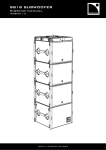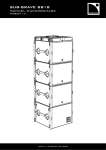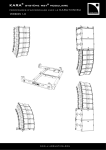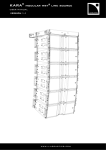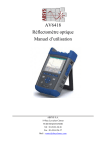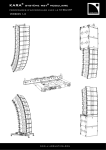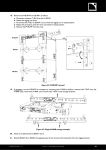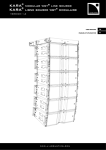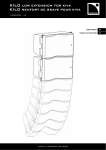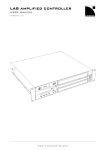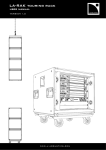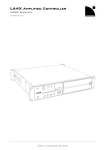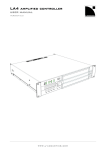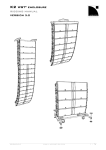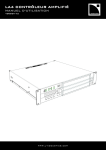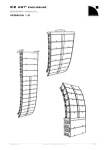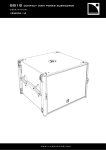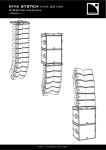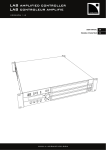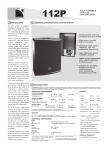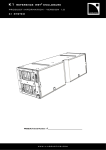Download KARA® - Scandec Systemer
Transcript
KARA® modular wst® system RIGGING PROCEDURES USING KARAKARA-MINIBU MINIBU VERSION 1. 1.0 0 www. l- aco usti cs. co m www.l-aco u sti cs.co m 1 SAFETY WARNINGS All information hereafter detailed applies for the L-ACOUSTICS® KARA-MINIBU rigging structure, KARAMINIBUEX extension bars, KARA-ANGARMEX angle arm extensions, or KARA-PULLBACK rigging accessory designated in this section as the product. 1.1 Symbol description Throughout this manual the potential risks are indicated by the following symbols: WARNING The WARNING symbol indicates a potential risk of physical harm to the user or people within close proximity to the product. In addition, the product may also be damaged. The CAUTION symbol notifies the user about information to prevent possible product damage. CAUTION The IMPORTANT symbol is a notification of an important recommendation of use. IMPORTANT 1.2 Important safety instructions 1. Read this manual 2. Heed all safety warnings 3. Follow all instructions 4. The user should never incorporate equipment or accessories not approved by L-ACOUSTICS® WARNING WARNING WARNING WARNING 5. Personnel qualification Installation and set-up should only be carried out by qualified personnel that are familiar with the rigging techniques and safety recommendations outlined in this manual. It is recommended to attend the training courses offered by L-ACOUSTICS® before proceeding with the loudspeaker assembling procedure. 6. Personnel health and safety During installation and set-up personnel should wear protective headgear and footwear at all times. Under no circumstances personnel should climb on the loudspeaker assembly. 7. System parts and rigging inspection All system components must be inspected before use in order to detect any possible defects. Please refer to the Care and Maintenance section of this manual as well as any other manuals pertaining to the system for a detailed description of the inspection procedure. Any part showing any sign of defect must immediately be put aside and withdrawn from use to be inspected by qualified service personnel. 8. Additional rigging equipment L-ACOUSTICS® is not responsible for any rigging equipment and accessories provided by third party manufacturers. It is the user’s responsibility to verify that the Working Load Limit (WLL) of all additional hardware rigging accessories is greater than the total weight of the loudspeaker assembly in use. KARA_SRM_EN_1-0 www.l-aco u sti cs.co m 1 KARA® MODULAR WST® SYSTEM rigging procedures using karakara-minibu VERSION 1.0 WARNING WARNING WARNING WARNING WARNING WARNING IMPORTANT 9. Suspension points It is the user’s responsibility to verify that the Working Load Limit (WLL) of the suspension points and/or chain hoists is greater than the total weight of the loudspeaker assembly in use. 10. Loudspeaker assembly load capacity and setup safety limits Load capacity and setup safety limits when flying or stacking a loudspeaker assembly should be strictly followed according to the instructions outlined in this manual. Always refer to the mechanical data and warning indications provided in SOUNDVISION Software (Mechanical Data section) [3.4] to ensure the mechanical conformity of the assembly before installation. 11. Local regulations Some countries require higher Ultimate Strength Safety Factors and specific rigging approvals. It is the user’s responsibility to verify that any overhead suspension of L-ACOUSTICS® loudspeaker assemblies has been made in accordance with all applicable local regulations. 12. Flying a loudspeaker assembly Always verify that nobody is standing underneath the loudspeaker assembly when it is being raised. As the assembly is being raised check each individual component to make sure that it is securely fastened to the component above. Never leave the assembly unattended during the installation process. As a general rule, L-ACOUSTICS® recommends the use of safety slings at all times. 13. Stacking a loudspeaker assembly Do not ground stack the assembly on unstable ground or platform. If the assembly is ground stacked on a structure, platform, or stage always check that the latter can support the total weight of the assembly. As a general rule, L-ACOUSTICS® recommends the use of safety straps at all times. 14. Dynamic load When a loudspeaker assembly is deployed in an open air environment, wind effects should be taken into account. Wind can produce dynamic stress to the rigging components and suspension points. If the wind force exceeds 6 bft (Beaufort scale) it is highly recommended to lower down and/or secure the loudspeaker assembly. 15. Manual Keep this manual in a safe place during the product lifetime. This manual forms an integral part of the product. Reselling of the product is only possible if the user manual is available. Any changes made to the product have to be documented in writing and passed on to the buyer in the event of resale. KARA_SRM_EN_1-0 www.l-aco u sti cs.co m 2 1.3 EC declaration of conformity L-ACOUSTICS® 13 rue Levacher Cintrat Parc de la Fontaine de Jouvence 91462 Marcoussis Cedex France States that the following products: Rigging structure, KARA-MINIBU Extension bars, KARA-MINIBUEX Angle arm extensions, KARA-ANGARMEX Rigging accessory, KARA-PULLBACK Are in conformity with the provisions of: Machinery Directive 2006/42/EC Applied rules and standards1: EN ISO 12100-1: 2004 (Mechanical Safety) DIN 18800 (Mechanical Structure) BGV-C1 (Mechanical Standard applied in Germany) Established at Marcoussis, France December 6th, 2010 Jacques Spillmann Head of Engineering & Design dept. 1 Maximum flown vertical array configurations: 6 KARA or 2 SB18/6 KARA or 4 SB18. Maximum stacked vertical array configuration: 6 KARA. KARA_SRM_EN_1-0 www.l-aco u sti cs.co m 3 KARA® MODULAR WST® SYSTEM rigging procedures using karakara-minibu VERSION 1.0 2 CONTENTS 1 1.1 1.2 1.3 SAFETY WARNINGS 1 Symbol description ............................................................................................................................................................. 1 Important safety instructions............................................................................................................................................... 1 EC declaration of conformity .............................................................................................................................................. 3 2 CONTENTS 3 3.1 3.2 3.3 3.4 INTRODUCTION 5 Welcome to L-ACOUSTICS® ............................................................................................................................................. 5 Symbol description ............................................................................................................................................................. 5 Unpacking .......................................................................................................................................................................... 5 Web links ........................................................................................................................................................................... 5 4 KARA® SYSTEM 5 5.1 5.2 5.3 5.4 KARA® RIGGING COMPONENTS 8 KARA-MINIBU ................................................................................................................................................................... 8 KARA-MINIBUEX, KARA-ANGARMEX.............................................................................................................................. 9 KARA-PULLBACK............................................................................................................................................................ 10 Flight-case ........................................................................................................................................................................ 10 6 6.1 INSTALLATION 11 Flying a KARA standalone array ......................................................................................................................................... 11 6.1.1 Modeling and safety.......................................................................................................................................... 11 6.1.2 Array assembling procedure ............................................................................................................................. 11 6.1.3 Array disassembling procedure ......................................................................................................................... 17 Flying a SB18/KARA mixed array or a SB18 standalone array.............................................................................................. 21 6.2.1 Modeling and safety.......................................................................................................................................... 21 6.2.2 Array assembling procedure ............................................................................................................................. 21 6.2.3 Array disassembling procedure ......................................................................................................................... 28 Stacking a KARA standalone array ..................................................................................................................................... 32 6.3.1 Modeling and safety.......................................................................................................................................... 32 6.3.2 Array assembling procedure ............................................................................................................................. 32 6.3.3 Array disassembling procedure ......................................................................................................................... 39 Stacking a SB18/KARA mixed array or a SB18 standalone array .......................................................................................... 43 6.4.1 Modeling and safety.......................................................................................................................................... 43 6.4.2 Array assembling procedure ............................................................................................................................. 43 6.4.3 Array disassembling procedure ......................................................................................................................... 52 6.2 6.3 6.4 4 6 7 7.1 7.2 CARE AND MAINTENANCE 58 Maintenance information .................................................................................................................................................. 58 Authorized service procedures ......................................................................................................................................... 59 7.2.1 Replacement kits and recommended tools........................................................................................................ 59 7.2.2 Laser support plate........................................................................................................................................... 60 7.2.3 Rubber feet...................................................................................................................................................... 60 8 SPECIFICATIONS 9 9.1 9.2 APPENDIX 63 LAP-TEQ inclinometer mounting ...................................................................................................................................... 63 Flown array options and site angle setting.......................................................................................................................... 64 9.2.1 KARA-MINIBU rigging options.......................................................................................................................... 64 9.2.2 KARA-MINIBU site angle setting....................................................................................................................... 65 9.2.3 KARA-PULLBACK setup safety limits................................................................................................................ 66 Stacked array options and site angle setting ....................................................................................................................... 67 9.3.1 Stacking platform configuration......................................................................................................................... 67 9.3.2 Array site angle setting ..................................................................................................................................... 68 Safety pin removal and insertion........................................................................................................................................ 69 9.3 9.4 KARA_SRM_EN_1-0 61 www.l-aco u sti cs.co m 4 3 INTRODUCTION 3.1 Welcome to L-ACOUSTICS® Thank you for purchasing the L-ACOUSTICS® KARA® Modular WST® System. This manual contains essential information on rigging the product correctly and safely. Read this manual carefully in order to become familiar with these procedures. As part of a continuous evolution of techniques and standards, L-ACOUSTICS® reserves the right to change the specifications of the product and the content of this manual without prior notice. Should the product requires repair or if information about the warranty is needed, please contact an approved L-ACOUSTICS® distributor. The address of the nearest distributor is available on the L-ACOUSTICS® web site. 3.2 Symbol description All along the manual, a bracketed number refers to a section. For example, [3.2] stands for the present Symbol description section. 3.3 Unpacking Carefully open the shipping carton and check the product for any noticeable damage. Each L-ACOUSTICS® product is tested and inspected before leaving the factory and should arrive in perfect condition. If found to be damaged, notify the shipping company or the distributor immediately. Only the consignee may initiate a claim with the carrier for damage incurred during shipping. Be sure to save the carton and packing materials for the carrier's inspection. Refer to [5] for full description of the shipping carton contents. 3.4 Web links Please check the L-ACOUSTICS® web site on a regular basis for latest document and software application updates. Table 1 provides links for all downloadable items mentioned in this manual. ALWAYS refer to the latest document version. ALWAYS use the latest software application version. IMPORTANT Table 1: Links to documents and software applications KARA User manual KARA Rigging procedures pack SB18 User manual TECH TOOLCASE Product spec sheet SOUNDVISION Software KARA_SRM_EN_1-0 www.l-acoustics.com/kara www.l-acoustics.com/sb18 www.l-acoustics.com/tech-toolcase www.l-acoustics.com/soundvision www.l-aco u sti cs.co m 5 KARA® MODULAR WST® SYSTEM rigging procedures using karakara-minibu VERSION 1.0 4 KARA® SYSTEM The L-ACOUSTICS® KARA-MINIBU, KARA-MINIBUEX, KARA-ANGARMEX, and KARA-PULLBACK elements have been designed to assemble the KARA® Modular WST® Line Source System as a flown or stacked vertical array. The system approach developed by L-ACOUSTICS® for KARA consists of the elements needed to fully take advantage of the possible configurations and optimize the system. The main components of the system are (see also Figure 1 and Figure 2): KARA® KARA-MINIBU KARA-MINIBUEX KARA-ANGARMEX KARA-PULLBACK SB18 SB28 LA8 LA NETWORK MANAGER SOUNDVISION Full range active 2-way modular WST® enclosure Structure for flying or stacking a small format KARA and/or SB18 array KARA-MINIBU extension accessories for SB18 rigging Angle arm extensions (x2) for stacked KARA arrays Rigging accessory for KARA array pullback configuration Compact high power subwoofer High power subwoofer Amplified controller Remote control software for amplified controllers Acoustical and mechanical modeling software Each loudspeaker assembly configuration should first be modeled using L-ACOUSTICS® SOUNDVISION Software [3.4] to verify its mechanical conformity. Please refer to the SOUNDVISION Help menu to obtain a detailed description on software use. LA8 LA NETWORK MANAGER SOUNDVISION Figure 1: KARA system components (part 1) KARA_SRM_EN_1-0 www.l-aco u sti cs.co m 6 KARA-MINIBU KARA-MINIBUEX KARA-PULLBACK SB28 KARA-ANGARMEX Figure 2: KARA system components (part 2) KARA_SRM_EN_1-0 www.l-aco u sti cs.co m 7 KARA® MODULAR WST® SYSTEM rigging procedures using karakara-minibu VERSION 1.0 5 KARA® RIGGING COMPONENTS 5.1 KARA-MINIBU The L-ACOUSTICS® KARA-MINIBU rigging structure has been designed to fly or stack the KARA® enclosures as a variable-curvature, vertical line source array. KARA-MINIBU also allows KARA to be attached to an SB18 subwoofer array. Note: KARA-MINIBU also can fly straight vertical SB18 arrays. The KARA-MINIBU is a rectangular frame fitted with the following elements: • Four 5/16” R-BLP (round-shaped ball-locking pins) for KARA rigging. • One laser support plate with four bolts for optional TEQSAS® LAP-TEQ laser/inclinometer device mounting. The LAP-TEQ is part of the L-ACOUSTICS® TECH TOOLCASE (refer to the TECH TOOLCASE Product spec sheet [3.4]). • Two shackles fitted with 12 mm/0.47 inch-diameter bolts and safety pins. • 17 shackle holes for rigging. • 2 shackle holes for pullback configurations. Note: Refer to [9.2.1] for distance between shackles. Shackle (x2) R-BLP (x4) Rigging holes (x17) Laser support plate Pullback hole (x2) Figure 3: KARA-MINIBU rigging structure KARA_SRM_EN_1-0 www.l-aco u sti cs.co m 8 5.2 KARA-MINIBUEX, KARA-ANGARMEX The L-ACOUSTICS® KARA-MINIBUEX is a set of two complementary rigging plates for KARA-MINIBU to adapt to the SB18 enclosure or to stack KARA. The L-ACOUSTICS® KARA-ANGARMEX is a set of two angle arm extensions providing extra 10° downwards site angle for the bottom KARA in stacked configurations. The KARA-MINIBUEX package comprises the following elements: • Two rigging plates featuring two rubber feet each. • Six bolts to assemble the KARA-MINIBU frame and two KARA-MINIBUEX plates. • Four 5/16” T-BLP (T-shaped ball-locking pins) to attach an SB18 enclosure to the KARA-MINIBU/KARAMINIBUEX structure. The KARA-ANGARMEX package comprises two angle arm extensions with 5/16” T-BLP. KARA-MINIBUEX Bolt (x6) KARA-MINIBU KARA-MINIBUEX T-BLP (x4) Flown configuration (feet pointing up) T-BLP Rubber foot (x4) Optional KARA-ANGARMEX (x2) Stacked configuration (feet pointing down) Figure 4: KARA-MINIBU/KARA-MINIBUEX rigging structure KARA_SRM_EN_1-0 www.l-aco u sti cs.co m 9 KARA® MODULAR WST® SYSTEM rigging procedures using karakara-minibu VERSION 1.0 5.3 KARA-PULLBACK The L-ACOUSTICS® KARA-PULLBACK rigging accessory will allow setting the KARA array in a pullback configuration. It attaches to the bottom enclosure of the array and to the hook or stinger of an additional motor. The KARA-PULLBACK is a plate on which is attached one shackle fitted with 19 mm/0.75 inchdiameter bolt and a safety pin. 5.4 Shackle Figure 5: KARA-PULLBACK rigging accessory Flight-case It is recommended to use a flight-case designed to ship a 3-KARA vertical array. It should contain foam inserts to prevent array movement and the tray should be fitted with 2 wedges to keep the array vertical. Complete flight-case Tray supporting a 3-KARA array Wedges Tray detail Figure 6: Recommended flight-case for KARA KARA_SRM_EN_1-0 www.l-aco u sti cs.co m 10 6 INSTALLATION 6.1 Flying a KARA standalone array 6.1.1 Modeling and safety Any loudspeaker assembly must be modeled before installation so as to ensure acoustical and mechanical conformity. This can be done using L-ACOUSTICS® SOUNDVISION Software [3.4] which will assist the user to: • Determine the number of required KARA enclosures. • Calculate the KARA-MINIBU site angle and the inter-enclosure angles. • Check the mechanical conformity of the loudspeaker assembly. The KARA-MINIBU can nominally fly an array of up to 6 KARA along with all loudspeaker cables (refer to the KARA User manual [3.4]). However, this maximum number can decrease in line with the array curvature. WARNING ALWAYS refer to the mechanical data and warning indications provided in SOUNDVISION software (Mechanical Data section) to verify the mechanical conformity of the loudspeaker assembly before installation. The KARA and KARA-MINIBU fully integrated rigging systems allow assembling the array with no need for any external accessory. The following first procedure describes how to fly a vertical KARA array under a KARA-MINIBU. It is recommended to assemble the KARA by successively adding arrays of 3 enclosures (called ARRAY#1 and ARRAY#2 in the order of appearance in the procedure). The second procedure describes how to disassemble the array. 6.1.2 WARNING Array assembling procedure All along the procedure: STRICTLY follow the sequence of the successive steps. SYSTEMATICALLY verify that each BLP is fully inserted. SYSTEMATICALLY verify that the bolt is fully driven and secured by a safety pin on each shackle. For clarity purposes the loudspeaker cabling procedure will not be described. The loudspeaker cables will not be represented in the figures. Use a strain relief to avoid mechanical stress at the connector locations due to cable weight. CAUTION The motor hooks or stingers will not be represented in the figures. 1. Bring a full KARA flight-case to the rigging location and remove the lid. Direct the front face of the KARA array towards the audience. In the following, the array will be designated as ARRAY#1 and the enclosures as KARA#1 to KARA#3 from top to bottom. 2. Check the inter-enclosure attachments in ARRAY#1 as follows (repeat on both sides of the array): a. Verify that each front arm (x2) is open and secured to the link holes of two KARA by two R-BLP. Note: A link hole is indicated by a yellow circle. b. Verify that each angle arm (x2) has the cursor aligned with the 0° angle label and is secured to two KARA by two R-BLP, the top one being inserted into the link hole and the bottom one into angle hole 0°/2°/4°. KARA_SRM_EN_1-0 www.l-aco u sti cs.co m 11 KARA® MODULAR WST® SYSTEM rigging procedures using karakara-minibu VERSION 1.0 b. a. KARA#1 KARA#2 0° KARA#3 ARRAY#1 Figure 7: Checking the ARRAY#1 inter-enclosure attachments 3. Open the four KARA#1 arms as follows (repeat on both sides of the enclosure): a. Remove the front top R-BLP from its storage hole, rotate the front arm up, slide it down, and lock it in place by re-inserting the R-BLP into its link hole. Note: The front top storage and link holes are the same. b. Remove the rear top R-BLP from its storage hole, slide the angle arm so as to align the cursor with angle label 5°, and lock it in place by re-inserting the R-BLP into angle hole 1°/3°/5°/7.5°/10°. It is recommended to select the 5° angle on the KARA intended to be attached to the KARAMINIBU; in that way the KARA#1 axis will be parallel to the KARA-MINIBU. IMPORTANT a. b. L L Figure 8: Opening the KARA#1 arms KARA_SRM_EN_1-0 www.l-aco u sti cs.co m 12 4. Attach a KARA-MINIBU to KARA#1 as follows: a. Remove the four R-BLP from the KARA-MINIBU. b. Turn the KARA-MINIBU so that the text of the identification plate is readable and the laser plate is placed at the front (towards audience). c. While keeping this orientation, align the four link points of KARA-MINIBU with the four arms of KARA#1 and secure each pair together by re-inserting the four R-BLP into the same holes (insert both rear R-BLP first). Note: If KARA-MINIBUEX extension accessories are already mounted to the KARA-MINIBU (see [6.2.2, step 1]), it is not necessary to remove them: the KARA-MINIBU/KARA-MINIBUEX rigging structure can also be used in place of the KARA-MINIBU. (x4) Identification plate Laser plate c. a. Figure 9: Attaching KARA-MINIBU to ARRAY#1 5. Attach the shackle(s) to the KARA-MINIBU [9.4] according to the chosen configuration [9.2]. Note: If the array is intended to be flown in pullback configuration, attach a single shackle to the rear pullback hole [5.1]. 6. Place ARRAY#1 beneath the rigging points and attach the motor hook(s) or stinger(s) to the shackle(s). 7. Raise the array to a height for which the angle arms of ARRAY#1 are within comfortable reach and remove the flight-case from the rigging location. KARA_SRM_EN_1-0 www.l-aco u sti cs.co m 13 KARA® MODULAR WST® SYSTEM rigging procedures using karakara-minibu VERSION 1.0 8. With 2 people working simultaneously on each side of ARRAY#1, set the inter-enclosure angles as follows: a. While grabbing the back handle of KARA#3, remove the KARA#2 rear top R-BLP from angle hole 0°/2°/4°. b. Rotate KARA#2 so as to align the angle arm cursor with the chosen angle label. c. Lock KARA#2 in place by re-inserting the R-BLP into the corresponding angle hole (0°/2°/4° or 1°/3°/5°/7.5°/10°). d. Repeat the procedure for KARA#3. b. c. a. Cursor d. L LL L Figure 10: Setting the ARRAY#1 inter-enclosure angles 9. Bring another full KARA flight-case to the rigging location and remove the lid. Direct the front face of the KARA array towards the audience. In the following, the array will be designated as ARRAY#2 and the enclosures as KARA#4 to KARA#6 from top to bottom. 10. Check the inter-enclosure attachments in ARRAY#2 by applying step 2. KARA#4 KARA#5 KARA#6 ARRAY#2 Figure 11: ARRAY#2 enclosure numbering convention 11. On KARA#4, open both front arms as follows (repeat for each one): remove the front top R-BLP from its storage hole, rotate the front arm up, and slide it down. Do NOT re-insert the R-BLP. 12. Raise ARRAY#1 slightly higher than the front arms of ARRAY#2 and place ARRAY#2 beneath ARRAY#1. KARA_SRM_EN_1-0 www.l-aco u sti cs.co m 14 13. Secure the front link points between ARRAY#1 and ARRAY#2 as follows: a. Slide each KARA#4 front arm up and align it with the KARA#3 front bottom link point. b. Secure each KARA#4 front arm to KARA#3 by removing the KARA#3 front bottom R-BLP from its storage hole and re-inserting it into its link hole. c. Lower the array until KARA#3 and KARA#4 front corners are in contact (keep the front arms vertical). d. Secure each front arm to KARA#4 by inserting the KARA#4 front top R-BLP into its link hole. c. b. KARA#3 KARA#4 a. d. Figure 12: Securing the ARRAY#1 and ARRAY#2 front link points together 14. Raise the array to a height for which the angle arms of ARRAY#2 are within comfortable reach and remove the flight-case from the rigging location. 15. With 2 people working simultaneously on each side of the array, secure the rear link points between ARRAY#1 and ARRAY#2 as follows: a. Remove the KARA#4 rear top R-BLP from its storage hole, slide the angle arm so as to align the cursor with the chosen angle label, and lock it in place by re-inserting the R-BLP into the corresponding angle hole (0°/2°/4° or 1°/3°/5°/7.5°/10°). b. While grabbing the back handle of KARA#6, rotate ARRAY#2 so as to align the KARA#3 and KARA#4 rear link points. c. Lock ARRAY#2 in place by removing the KARA#3 rear bottom R-BLP from its storage hole and re-inserting it into its link hole. a. c. L KARA#3 KARA#4 b. Figure 13: Securing the ARRAY#1 and ARRAY#2 rear link points together KARA_SRM_EN_1-0 www.l-aco u sti cs.co m 15 KARA® MODULAR WST® SYSTEM rigging procedures using karakara-minibu VERSION 1.0 16. Set the inter-enclosure angles in ARRAY#2 by applying step 8. Figure 14: Example of flown KARA homogeneous array 17. If the array is intended to be flown in pullback configuration, attach a KARA-PULLBACK to the bottom KARA as follows: a. Align the KARA-PULLBACK studs with the KARA link points (long studs at the back). b. Remove the four KARA bottom R-BLP from their storage holes and re-insert them into their link holes. c. Attach the hook or stinger of an additional motor to the KARA-PULLBACK shackle. Refer to [9.2.3] for KARA-PULLBACK setup safety limits. WARNING Figure 15: Attaching KARA-PULLBACK to KARA 18. Raise the array to the chosen height and adjust the site angle [9.2.2]. 19. Secure the KARA-MINIBU to the main rigging structure by using two safety slings (not included). KARA_SRM_EN_1-0 www.l-aco u sti cs.co m 16 6.1.3 WARNING Array disassembling procedure All along the procedure: STRICTLY follow the sequence of the successive steps. SYSTEMATICALLY verify that each BLP is fully inserted. For clarity purposes the loudspeaker cable removal procedure will not be described. The loudspeaker cables will not be represented in the figures. CAUTION 1. Detach both safety slings from the KARA-MINIBU. 2. Lower the array to a height for which the angle arms of ARRAY#2 are within comfortable reach. 3. If the array to disassemble has been flown in pullback configuration, separate the KARA-PULLBACK from the bottom KARA as follows: a. Lower the pullback chain so as to release tension and detach the motor hook or stinger from the shackle. b. While holding the KARA-PULLBACK, remove the four KARA bottom R-BLP from their link holes and re-insert them into their storage holes. c. Remove the KARA-PULLBACK. 4. With 2 people working simultaneously on each side of ARRAY#2, set the inter-enclosure angles to 0° as follows: a. While grabbing the back handle of KARA#6, remove the KARA#5 rear top R-BLP from its angle hole. b. Rotate KARA#5 so as to align the cursor of the angle arm with angle label 0°. c. Lock KARA#5 in place by re-inserting the R-BLP into angle hole 0°/2°/4°. d. Repeat the procedure for KARA#6. KARA#1 ARRAY#1 b. KARA#2 L L L LL KARA#3 KARA#4 c. 0° ARRAY#2 KARA#5 d. KARA#6 a. Figure 16: Setting the ARRAY#2 inter-enclosure angles 5. Bring an empty KARA flight-case to the rigging location, remove the lid, and place the tray beneath ARRAY#2. Pay attention to the tray position: both wedges must slope upwards from front to rear [5.4]. WARNING 6. Lower the array slightly higher than the tray. KARA_SRM_EN_1-0 www.l-aco u sti cs.co m 17 KARA® MODULAR WST® SYSTEM rigging procedures using karakara-minibu VERSION 1.0 7. With 2 people working simultaneously on each side of the array, disconnect the rear link points between ARRAY#1 and ARRAY#2 as follows: a. While grabbing the back handle of KARA#5, remove the KARA#3 rear bottom R-BLP from its link hole and re-insert it into its storage hole. b. Rotate ARRAY#2 downwards and position the rear corners into the tray while still suspended from the front link points. c. Remove the KARA#4 rear top R-BLP from its angle hole, slide the angle arm so as to align the cursor with the storage label, and re-insert the R-BLP into its storage hole. c. a. L KARA#3 KARA#4 b. Figure 17: Disconnecting the ARRAY#1 and ARRAY#2 rear link points L 8. Lower the array until ARRAY#2 rests in the tray and the front link points between ARRAY#2 and ARRAY#1 are in contact. 9. Disconnect the front link points between ARRAY#1 and ARRAY#2 as follows: a. Remove both KARA#4 front top R-BLP from their link holes. b. Slightly raise ARRAY#1 so that it is no longer in contact with ARRAY#2. c. Remove both KARA#3 front bottom R-BLP from their link holes and re-insert them into their storage holes. d. Rotate both KARA#4 front arms down and re-insert both front top R-BLP into their storage holes. Note: The front top storage and link holes are the same. b. c. KARA#3 KARA#4 d. a. d. Figure 18: Disconnecting the ARRAY#1 and ARRAY#2 front link points KARA_SRM_EN_1-0 www.l-aco u sti cs.co m 18 10. Remove ARRAY#2 from the rigging location and put the flight-case lid on. 11. Lower the array to a height for which the angle arms of ARRAY#1 are within comfortable reach and set the angles to 0° by applying step 4. 12. Bring another empty flight-case to the rigging location, remove the lid, and place the tray beneath ARRAY#1. Pay attention to the tray position: both wedges must slope upwards from front to rear [5.4]. WARNING 13. Lower ARRAY#1 into the tray. Lower the motor chain(s) so as to release tension. 14. Separate the KARA-MINIBU from KARA#1 as follows: a. Detach the motor hook(s) or stinger(s) from the KARA-MINIBU. b. Remove the four R-BLP from the KARA-MINIBU. c. Separate the KARA-MINIBU from KARA#1 and re-insert the four R-BLP into the same holes. (x4) c. b. Figure 19: Separating KARA-MINIBU from KARA#1 KARA_SRM_EN_1-0 www.l-aco u sti cs.co m 19 KARA® MODULAR WST® SYSTEM rigging procedures using karakara-minibu VERSION 1.0 15. Close the four KARA#1 arms as follows (repeat on both sides of the enclosure): a. Remove the front top R-BLP from its link hole, slide the front arm up, rotate it down, and lock it in place by re-inserting the R-BLP into its storage hole. b. Remove the rear top R-BLP from its angle hole, slide the angle arm so as to align the cursor with the storage label, and lock it in place by re-inserting the R-BLP into its storage hole. a. b. L L Figure 20: Closing the KARA#1 arms 16. Put the flight-case lid on. KARA_SRM_EN_1-0 www.l-aco u sti cs.co m 20 6.2 Flying a SB18/KARA mixed array or a SB18 standalone array 6.2.1 Modeling and safety Any loudspeaker assembly must be modeled before installation so as to ensure acoustical and mechanical conformity. This can be done using L-ACOUSTICS® SOUNDVISION Software [3.4] which will assist the user to: • Determine the number of required KARA enclosures (acoustic data not available for subwoofers). • Calculate the array site angle and the inter-enclosure angles. • Check the mechanical conformity of the loudspeaker assembly. The KARA-MINIBU/KARA-MINIBUEX structure can nominally fly an array of up to 2 SB18/6 KARA or 4 SB18 along with all loudspeakers cables (refer to the KARA and SB18 User manuals [3.4]). However, this maximum number can decrease in line with the array curvature. WARNING ALWAYS refer to the mechanical data and warning indications provided in SOUNDVISION software (Mechanical Data section) to verify the mechanical conformity of the loudspeaker assembly before installation. NEVER assemble an array containing an M-BUMP on top and a KARA-MINIBU/KARA-MINIBUEX between SB18 and KARA for mechanical stress purposes (refer to the KARA Rigging procedures pack [3.4] for M-BUMP description). WARNING On the contrary, it is possible to assemble an array containing a KARA-MINIBU/KARA-MINIBUEX on top and an M-BUMP between SB18 and KARA. In such a case, select the KARA-MINIBU/KARA-MINIBUEX structure in SOUNDVISION to verify the mechanical conformity of the loudspeaker assembly. The KARA, SB18, KARA-MINIBU, and KARA-MINIBUEX fully integrated rigging systems allow assembling the array with no need for any external accessory. The following first procedure describes how to fly a vertical SB18/KARA array using two KARA-MINIBU/KARAMINIBUEX rigging structures. It is recommended to assemble the KARA by successively adding arrays of 3 enclosures (called ARRAY#1, ARRAY#2 in the order of appearance in the procedure). The second procedure describes how to disassemble the array. 6.2.2 WARNING CAUTION Array assembling procedure All along the procedure: STRICTLY follow the sequence of the successive steps. SYSTEMATICALLY verify that each BLP is fully inserted. SYSTEMATICALLY verify that the bolt is fully driven and secured by a safety pin on each shackle. SYSTEMATICALLY verify that each bolt is fully driven on the KARA-MINIBUEX. For clarity purposes the loudspeaker cabling procedure will not be described. The loudspeaker cables will not be represented in the figures. Use a strain relief to avoid mechanical stress at the connector locations due to cable weight. The motor hooks or stingers will not be represented in the figures. Required tools Electric screwdriver with torque selector (N.m or in.lbf), 6 mm hex bit, 13 mm hex key. Procedure 1. Assemble a KARA-MINIBU/KARA-MINIBUEX rigging structure as follows: a. Turn the KARA-MINIBU so that the text of the identification plate is readable. b. Position a first KARA-MINIBUEX on the laser plate side of the KARA-MINIBU by turning it feet pointing up and inserting the stud into the slit of the KARA-MINIBU located near the laser plate. c. Drive 3 bolts into the 3 holes shown in Figure 21 (6 mm hex bit, 13 mm hex key, 7 N.m/63 in.lbf). d. Repeat the procedure with a second KARA-MINIBUEX on the other side of the KARA-MINIBU. e. Attach the shackle(s) to the KARA-MINIBU [9.4] according to the chosen configuration [9.2]. Note: If the array is intended to be flown in pullback configuration, attach a single shackle to the rear pullback hole [5.1]. KARA_SRM_EN_1-0 www.l-aco u sti cs.co m 21 KARA® MODULAR WST® SYSTEM rigging procedures using karakara-minibu VERSION 1.0 Shackle (x2) b. Stud inserted into slit Identification plate KARA-MINIBU Laser plate KARA-MINIBUEX (x2) c. Bolts (x3) T-BLP (x4) Figure 21: Assembling a KARA-MINIBU/KARAMINIBUEX rigging structure 2. Assemble two SB18 (hereafter called SB18#1 and SB18#2) at the rigging location as follows: a. Bring two SB18 to the rigging location and remove the dolly boards. b. Arrange both SB18 in a vertical array, front faces towards audience and logos down. In the following, SB18#1 will designate the top subwoofer and SB18#2 the bottom one. c. Remove a T-BLP from SB18#2, rotate the link arm up, and re-insert the T-BLP into the SB18#1 link point and the link arm. Repeat this procedure until all four arms are secured. SB18#1 c. (x4) Towards audience SB18#2 Figure 22: Assembling two SB18 KARA_SRM_EN_1-0 www.l-aco u sti cs.co m 22 3. Attach the rigging structure to SB18#1 as follows: a. Remove the four T-BLP from the top part of SB18#1 and turn the four link arms up. b. According to the chosen configuration [9.2], position the rigging structure above SB18#1 and lower it so as to slide the SB18#1 link arms into the KARA-MINIBUEX arm guides. c. Re-insert the four T-BLP into the KARA-MINIBUEX link points and the SB18#1 link arms. Arm guide (x4) c. SB18#1 b. a. Rigging arm Towards audience a. SB18#2 Figure 23: Attaching the rigging structure to SB18#1 4. Attach the motor hook(s) or stinger(s) to the shackle(s) and raise the array to a height of 1.3 m/4.3 ft. 5. If the array is intended to be a SB18/KARA mixed array, directly go to step 9. If the array is intended to be a SB18 standalone array, assemble two additional SB18 enclosures (hereafter called SB18#3 and SB18#4) under the array by applying step 2 and then continue the procedure from step 6 below. IMPORTANT KARA_SRM_EN_1-0 Turn the front faces of all SB18 composing the array towards the audience to obtain an omnidirectional acoustic pattern or turn one SB18 every fourth from front to rear to obtain a cardioid acoustic pattern (refer to the SB18 User manual [3.4]). As an example, Figure 24 shows a cardioid array. www.l-aco u sti cs.co m 23 KARA® MODULAR WST® SYSTEM rigging procedures using karakara-minibu VERSION 1.0 6. Attach SB18#3 to SB18#2 as follows: a. While aligning the four link points between SB18#2 and SB18#3, lower the array onto SB18#3. b. Remove a T-BLP from SB18#3. c. Rotate the link arm up. d. Secure the link arm to SB18#2 by re-inserting the T-BLP into the SB18#2 bottom link point. e. Repeat the last three steps until all four arms are secured to SB18#2. SB18#1 d. SB18#2 (x4) c. b. SB18#3 SB18#4 reversed for cardioid application Figure 24: Attaching SB18#3 to SB18#2 7. Raise the array to the chosen height. 8. Secure the KARA-MINIBU to the main rigging structure by using two safety slings (not included). END OF THE PROCEDURE 9. Bring a full KARA flight-case to the rigging location and remove the lid. Direct the front face of the KARA array towards the audience. In the following, the array will be designated as ARRAY#1 and the enclosures as KARA#1 to KARA#3 from top to bottom. KARA_SRM_EN_1-0 www.l-aco u sti cs.co m 24 10. Check the inter-enclosure attachments in ARRAY#1 as follows (repeat on both sides of the array): a. Verify that each front arm (x2) is open and secured to the link holes of two KARA by two R-BLP. Note: A link hole is indicated by a yellow circle. b. Verify that each angle arm (x2) has the cursor aligned with angle label 0° and is secured to two KARA by two R-BLP, the top one being inserted into the link hole and the bottom one into angle hole 0°/2°/4°. b. a. KARA#1 KARA#2 0° KARA#3 ARRAY#1 Figure 25: Checking the ARRAY#1 inter-enclosure attachments 11. Open the four KARA#1 arms as follows (repeat on both sides of the enclosure): a. Remove the front top R-BLP from its storage hole, rotate the front arm up, slide it down, and lock it in place by re-inserting the R-BLP into the front top link hole. Note: The front top storage and link holes are the same. b. Remove the rear top R-BLP from its storage hole, slide the angle arm so as to align the cursor with angle label 5°, and lock it in place by re-inserting the R-BLP into angle hole 1°/3°/5°/7.5°/10°. It is recommended to select the 5° angle on the KARA intended to be attached to the KARAMINIBU; in that way the KARA#1 axis will be parallel to the KARA-MINIBU. IMPORTANT a. b. L L Figure 26: Opening the KARA#1 arms KARA_SRM_EN_1-0 www.l-aco u sti cs.co m 25 KARA® MODULAR WST® SYSTEM rigging procedures using karakara-minibu VERSION 1.0 12. Assemble another KARA-MINIBU/KARA-MINIBUEX rigging structure by applying step 1 WITHOUT attaching shackles. 13. Attach the rigging structure to KARA#1 as follows: a. Remove the four R-BLP from the KARA-MINIBU. b. Turn the KARA-MINIBU so that the text of the identification plate is readable and the laser plate is placed at the front (towards the audience). c. While keeping this orientation, align the four link points of KARA-MINIBU with the four arms of KARA#1 and secure each pair together by re-inserting the four R-BLP into the same holes (insert both rear R-BLP first). Note: The KARA-MINIBUEX elements must extend beyond the rear of the array. (X4) Identification plate Laser plate c. a. LL Figure 27: Attaching the rigging structure to ARRAY#1 14. Place ARRAY#1 beneath the SB18 array. KARA_SRM_EN_1-0 www.l-aco u sti cs.co m 26 15. Attach ARRAY#1 to the SB18 array as follows: a. Remove the four T-BLP from the storage holes of both KARAMINIBUEX. b. Lower the SB18 array so as to align its four bottom link points with those of both KARA-MINIBUEX. Note: Do NOT stack the SB18 array onto the KARA array. c. Secure the link points together by re-inserting the four T-BLP into the KARA-MINIBUEX and bottom SB18 link holes. b. L L L L L c. a. c. a. Figure 28: Attaching ARRAY#1 to the SB18 array 16. Continue the procedure by applying [6.1.2, steps 7 to 19]. Figure 29: Examples of flown SB18/KARA mixed arrays KARA_SRM_EN_1-0 www.l-aco u sti cs.co m 27 KARA® MODULAR WST® SYSTEM rigging procedures using karakara-minibu VERSION 1.0 6.2.3 WARNING Array disassembling procedure All along the procedure: STRICTLY follow the sequence of the successive steps. SYSTEMATICALLY verify that each BLP is fully inserted. For clarity purposes the loudspeaker cable removal procedure will not be described. The loudspeaker cables will not be represented in the figures. CAUTION 1. If the array to disassemble is a SB18 standalone array, directly go to step 8. If the array to disassemble is a SB18/KARA mixed array, begin the procedure by applying [6.1.3, steps 1 to 12] and then continue from step 2 below. 2. Lower ARRAY#1 into the tray. The bottom SB18 must be resting on both KARA-MINIBUEX. 3. Separate ARRAY#1 from the SB18 array as follows: a. Remove the four T-BLP from the link holes of both KARA-MINIBUEX. b. Raise the SB18 array until it is separated from ARRAY#1. c. Re-insert the four T-BLP into the KARA-MINIBUEX storage holes. b. a. L L L L L a. c. c. Figure 30: Separating ARRAY#1 from the SB18 array 4. Remove ARRAY#1 from under the SB18 array. KARA_SRM_EN_1-0 www.l-aco u sti cs.co m 28 5. Separate the KARA-MINIBU/KARA-MINIBUEX rigging structure from KARA#1 as follows: a. Remove the four R-BLP from the KARA-MINIBU. b. Separate the rigging structure from ARRAY#1. c. Re-insert the four R-BLP into the same KARA-MINIBU holes. (X4) a. c. LL Figure 31: Separating the rigging structure from KARA#1 6. Close the four KARA#1 arms as follows (repeat on both sides of the enclosure): a. Remove the front top R-BLP from its link hole, slide the front arm up, rotate it down, and lock it in place by re-inserting the R-BLP into its storage hole. b. Remove the rear top R-BLP from its angle hole, slide the angle arm so as to align the cursor with the storage label, and lock it in place by re-inserting the R-BLP into its storage hole. a. b. L L Figure 32: Closing the KARA#1 arms 7. Put the flight-case lid on. The procedure is continued with an array composed of four SB18 enclosures to cover all possible cases. IMPORTANT KARA_SRM_EN_1-0 www.l-aco u sti cs.co m 29 KARA® MODULAR WST® SYSTEM rigging procedures using karakara-minibu VERSION 1.0 8. If not already done, detach both safety slings from the KARA-MINIBU. 9. Lower the array until the bottom SB18 (SB18#4 for example) rests on the ground and the SB18 above (SB18#3 for example) rests onto it. 10. Separate SB18#3 from SB18#2 as follows: a. Remove a T-BLP from a SB18#2 bottom link point. b. Rotate the link arm down. c. Lock the link arm in closed position by re-inserting the T-BLP into SB18#3. d. Repeat this procedure until all four arms are locked in closed position. SB18#1 a. SB18#2 (x4) b. c. SB18#3 SB18#4 Figure 33: Separating SB18#3 from SB18#2 11. Raise the array until SB18#2 is separated from SB18#3. 12. Attach a dolly board to each of the SB18#3 and SB18#4 subwoofers. 13. Separate SB18#4 from SB18#3 by applying steps 10. 14. Remove SB18#3 and SB18#4 from the rigging location. 15. Lower the array until it rests on the ground. 16. Detach the motor hook(s) or stinger(s) from the KARA-MINIBU shackle(s). KARA_SRM_EN_1-0 www.l-aco u sti cs.co m 30 17. Separate the KARA-MINIBU/KARA-MINIBUEX rigging structure from SB18#1 as follows: a. Remove the four T-BLP from both KARA-MINIBUEX. b. Lift the rigging structure up and separate it from SB18#1. c. Rotate the four SB18#1 link arms down. d. Lock the link arms in closed position by re-inserting the four T-BLP into the top SB18#1 link points. b. (x4) a. SB18#1 c. d. SB18#2 Figure 34: Separating the rigging structure from SB18#1 18. Attach a dolly board to each subwoofer. 19. Separate SB18#2 from SB18#1 by applying step 10 and remove both subwoofers from the rigging location. KARA_SRM_EN_1-0 www.l-aco u sti cs.co m 31 KARA® MODULAR WST® SYSTEM rigging procedures using karakara-minibu VERSION 1.0 6.3 Stacking a KARA standalone array 6.3.1 Modeling and safety A KARA array must be stacked onto a KARA-MINIBU/KARA-MINIBUEX platform (platform stacked array). Any platform stacked array must be modeled before installation so as to ensure acoustical conformity. This can be done using L-ACOUSTICS® SOUNDVISION Software [3.4] which will assist the user to: • Determine the number of required KARA enclosures. • Calculate the inter-enclosure angles. A platform stacked array requires to be installed on a perfectly horizontal and regular surface. It can be composed of a maximum of 6 KARA enclosures along with all loudspeaker cables (refer to the KARA User manual [3.4]) within the following setup safety limits: WARNING • If the KARA array is flat (all inter-enclosure angles are close to 0°), the platform must be installed in front extension configuration (refer to [9.3.1]) and the site angle of the bottom KARA must be set within the range given in Table 2 (refer to [9.3.2] for angle settings): Table 2: Platform stacked KARA array safe configurations Number of KARA 1-3 4 5-6 Bottom KARA authorized angle range From -15° to +5° From -11° to +5° From -7.5° to +5° • If the KARA array is strongly curved (all inter-enclosure angles are close to 10°), the platform must be installed in rear extension configuration (refer to [9.3.1]). The KARA, KARA-MINIBU, and KARA-MINIBUEX fully integrated rigging systems allow assembling the array with no need for any external accessory. The following first procedure describes how to assemble a vertical KARA platform stacked array. The second procedure describes how to disassemble the array. 6.3.2 Array assembling procedure All along the procedure: STRICTLY follow the sequence of the successive steps. SYSTEMATICALLY verify that each BLP is fully inserted. WARNING SYSTEMATICALLY verify that each bolt is fully driven on the KARA-MINIBUEX. For clarity purposes the loudspeaker cabling procedure will not be described. The loudspeaker cables will not be represented in the figures. CAUTION Required tools Electric screwdriver with torque selector (N.m or in.lbf), 6 mm hex bit, 13 mm hex key. Procedure 1. Assemble a KARA-MINIBU/KARA-MINIBUEX stacking platform as follows: a. Turn the KARA-MINIBU so that the text of the identification plate is upside down. b. Position a first KARA-MINIBUEX on the laser plate side of the KARA-MINIBU by turning the KARAMINIBUEX feet pointing down and inserting the stud into the slit of the KARA-MINIBU located near the laser plate. c. Drive 3 bolts to the 3 holes shown in Figure 35 (6 mm hex bit, 13 mm hex key, 7 N.m/63 in.lbf). d. Repeat the procedure with a second KARA-MINIBUEX on the other side of the KARA-MINIBU. KARA_SRM_EN_1-0 www.l-aco u sti cs.co m 32


































